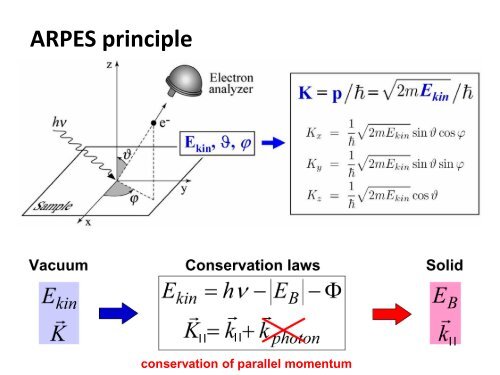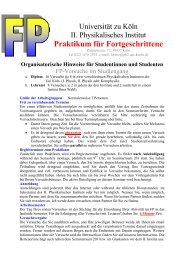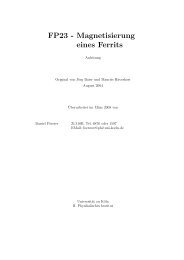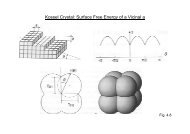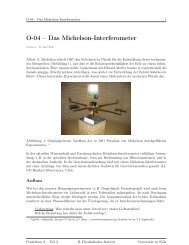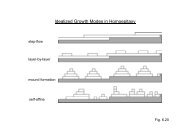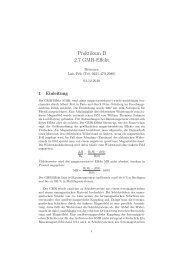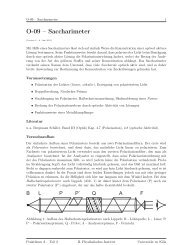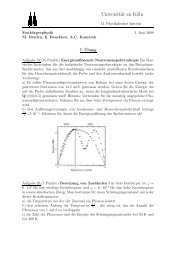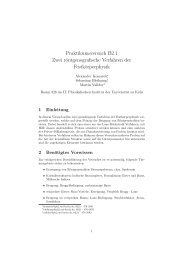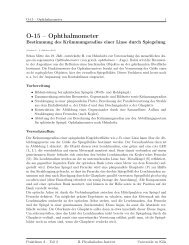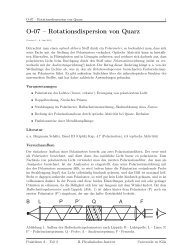Experimental methods in solid state physics
Experimental methods in solid state physics
Experimental methods in solid state physics
You also want an ePaper? Increase the reach of your titles
YUMPU automatically turns print PDFs into web optimized ePapers that Google loves.
ARPES pr<strong>in</strong>ciple<br />
|| ||<br />
||<br />
conservation of parallel momentum
ARPES on graphene
Inverse photoemission spectroscopy<br />
1<br />
2
Two-photon photoemission (2PPE)
X-ray adsorption spectroscopy
XAS experimentally<br />
4f<br />
• Fluorescence Yield (bulk sensitive, but<br />
often saturation problems)<br />
• Transmission mode: I(h)=I 0 e -z sample<br />
• Total Yield (TY):<br />
All (<strong>in</strong>-) elastic photoelectrons<br />
Prob<strong>in</strong>g depth: 40Å to 100Å<br />
good signal to noise ratio (I~100 pA)<br />
Detektor<br />
3d<br />
e -<br />
h<br />
• Partial Electron Yield (PEY):<br />
only photo electrons with E k<strong>in</strong> ≥E threshold , i.e. elastic photo<br />
electrons (ca. 5% of TY-signal)<br />
prob<strong>in</strong>g depth: ~15Å (surface)<br />
I<br />
All <strong>methods</strong> can be measured simultaniously to get more <strong>in</strong>formation
Dipole radiation<br />
Emission characteristics (A=<strong>in</strong>tensity)<br />
Dipole antenna (harmonic oscillation<br />
of charge) with <strong>in</strong>duced E- and B-field<br />
3D-view
Electrons on circular orbit<br />
nonrelativistic<br />
relativistic<br />
P<br />
Radiation Power P<br />
<br />
2<br />
3<br />
2<br />
e c 4<br />
<br />
2<br />
R<br />
<br />
E<br />
m c<br />
2<br />
0<br />
<br />
<br />
<br />
<br />
4<br />
open<strong>in</strong>g angle θ<br />
nonrelativistic:<br />
v
Generation of Synchrotron Radiation<br />
1. emission of electrons by an electron gun<br />
2. acceleration <strong>in</strong> a l<strong>in</strong>ear accelerator (LINAC)<br />
3. transmission to a circular accelerator<br />
(booster synchrotron) to reach the required<br />
energy level (e.g. E = 6 GeV at ESRF)<br />
relativistic electrons<br />
4. <strong>in</strong>jection of high energy electrons <strong>in</strong>to a<br />
large storage r<strong>in</strong>g (circumfence e.g. 844 m<br />
at ESRF) where they circulate <strong>in</strong> vacuum at<br />
a constant energy for many hours<br />
Velocity of relativistic electrons (6 GeV) v is only 107 cm/s slower<br />
than the velocity of light
Storage r<strong>in</strong>gs and beaml<strong>in</strong>es
Angular distribution (relativistic)<br />
Radiation from bend<strong>in</strong>g magnet<br />
Example:<br />
E = 6 GeV, v is only 107 cm/s slower than the velocity of light (c 3 10 10 cm/s)<br />
γ = E/mc 2 1820<br />
θ 8 10 -5 rad (0.08 mrad)<br />
The emitted radiation is a sharp cone with an open<strong>in</strong>g angle θ 0.08 mrad<br />
Excellent collimation!<br />
<strong>in</strong> a distance of 50 m from the source, one obta<strong>in</strong>s a spot of only ~ 4 mm!
Electric Field<br />
Pulse duration and energy spectrum<br />
electron<br />
trajectory<br />
1/γ<br />
1/γ<br />
Duration of radiation flash<br />
(s<strong>in</strong>gle electron):<br />
t <br />
4R<br />
3c<br />
3<br />
E c<br />
E c<br />
E<br />
E<br />
c<br />
keV<br />
0.665BT<br />
EGeV<br />
<br />
R<br />
<br />
c<br />
5.59 <br />
E<br />
3<br />
2<br />
E c<br />
broad energy spectrum!
Charaterize the properties of a Synchrotron Radiation source<br />
Brilliance is the figure of merit for the design of new Synchrotron Radiation sources
Emission spectrum<br />
Nombre<br />
de photons<br />
10 14<br />
1013<br />
10 12 10000 1000 100 10 1 0.1<br />
10 11<br />
Longueur d'onde (Å)<br />
Bend<strong>in</strong>g<br />
magnet<br />
10 10<br />
10 9<br />
10 8<br />
10 7<br />
Sun<br />
1 eV 10 eV 100 eV 1 keV 10 keV 100 keV<br />
Energie<br />
X-ray<br />
tubes
Synchrotron radiation<br />
Extremely high <strong>in</strong>tensity, broad energy<br />
Lasers à<br />
range<br />
Emission spectrum<br />
Number<br />
Nombre<br />
de photons of<br />
photons<br />
10 14<br />
1013<br />
Brillance<br />
Brilliance<br />
(photons/s/mm 2 /mrad 2 /0.1%BW)<br />
(photons/s/mm 2 /mrad 2 /0.1%B.F.)<br />
10 12 10000 1000 100 10 1 0.1<br />
10 11<br />
10 10<br />
10 9<br />
10 8<br />
10 7<br />
Longueur Wavelength d'onde (Å) (Å)<br />
Sun<br />
1 eV 10 eV 100 eV 1 keV 10 keV 100 keV<br />
Energie Energy<br />
Bend<strong>in</strong>g<br />
magnet<br />
X-ray<br />
tubes<br />
10 23<br />
10 22<br />
10 21<br />
10 20<br />
10 19<br />
10 18<br />
10 17<br />
10 16<br />
10 15<br />
10 14<br />
10 13<br />
10 12<br />
10 11<br />
10 10<br />
10 9<br />
10 8<br />
10 7<br />
10 6<br />
3ème ESRF ESRF (future) (2000)<br />
generation 3rd<br />
ESRF (2000)<br />
generation<br />
ESRF (1994)<br />
ESRF (1994)<br />
2ème generation<br />
2nd generation<br />
1ère génération<br />
1st generation<br />
Limite de diffraction<br />
X-ray Tubes à<br />
tubes rayons X<br />
ESRF (futur)<br />
électrons libres<br />
1900 1900 1920 19201940 19401960 19601980 19802000<br />
2000<br />
Years Années<br />
Free<br />
electron<br />
lasers<br />
Rayonn<br />
synchr
Magnetic wigglers and undulator (N periods)<br />
Pr<strong>in</strong>ciple:<br />
periodic arrangement of short bend<strong>in</strong>g<br />
magnets of alternat<strong>in</strong>g polarity perpendicular<br />
to the plane of the storage r<strong>in</strong>g<br />
Permanent<br />
magnetic materials<br />
e.g. Nd-Fe-B<br />
force the electrons to oscillate („wiggle“) perpendicular to their direction of motion<br />
Radiation is emitted dur<strong>in</strong>g each <strong>in</strong>dividual wiggle<br />
<strong>in</strong>crease of the <strong>in</strong>tensity
wiggler and undulator<br />
Deflection parameter<br />
Wiggler regime: α > 1/γ<br />
Wiggler: <strong>in</strong>tensity <strong>in</strong>creases as 2N (N: number of poles)<br />
Undulator regime: α ~ 1/γ<br />
Undulator: <strong>in</strong>tensity <strong>in</strong>creases as N 2<br />
In the undulator regime the radiation cones overlap and the wave tra<strong>in</strong>s can <strong>in</strong>terfere
Forms of Synchrotron Radiation
Spectral Brightness
Examples of Wigglers and Undulators
Evolution of Brilliance<br />
SRS = Synchrotron Radiation Source<br />
1 st generation: Exploitation of the light from the bend<strong>in</strong>g magnets of e+/e- colliders<br />
orig<strong>in</strong>ally built for elementary particle <strong>physics</strong><br />
2 nd generation: Radiation from bend<strong>in</strong>g magnets and <strong>in</strong>troduction of first <strong>in</strong>sertion<br />
devices, lower e-beam emittance, optimization of light extraction<br />
3 rd generation: dedicated storage r<strong>in</strong>gs, very low e-beam emittance, brilliance is<br />
figure of merit, ma<strong>in</strong>ly undulators, long straight sections
European Synchrotron Radiation Facility (ESRF)
Beaml<strong>in</strong>e organization<br />
This is a typical x-ray beaml<strong>in</strong>e.<br />
Optics hutch conta<strong>in</strong>s elements for condition<strong>in</strong>g the x-ray beam.<br />
Storage r<strong>in</strong>g<br />
Cyl<strong>in</strong>drical<br />
mirror
How does a beaml<strong>in</strong>e work?
X-ray monochromator us<strong>in</strong>g perfect crystal<br />
Basic pr<strong>in</strong>ciple of monochromator:<br />
Bragg reflection from perfect s<strong>in</strong>gle crystal<br />
2d hkl s<strong>in</strong>θ = nλ<br />
d: Lattice (d)-spac<strong>in</strong>g,<br />
θ: glanc<strong>in</strong>g angle,<br />
λ: X-ray wavelength<br />
Crystal: silicon, diamond,...<br />
Select photon energy range by us<strong>in</strong>g:<br />
- specific crystal, lattice plane<br />
- Bragg angle range
Energy range of standard monochromator<br />
Example: SPr<strong>in</strong>g-8 standard monochromator<br />
Bragg Reflection<br />
Si 111<br />
Si 311<br />
Si 511<br />
…..<br />
Bragg angles<br />
3~27°<br />
Energy range<br />
4.4~110 keV<br />
Photon energy (wavelength) can be selected<br />
by crystal, net planes, and Bragg angle.
Double crystal monochromator<br />
Problems with s<strong>in</strong>gle crystal monochromators<br />
• the monochromatic beam moves when the energy<br />
is changed<br />
• high harmonic content<br />
• big tails<br />
Solution: double crystal design!<br />
Simplest design: cutt<strong>in</strong>g a channel<br />
for the beam <strong>in</strong> a silicon block<br />
(channel cut monochromator)<br />
• Use the same crystals and d-spac<strong>in</strong>g<br />
for 1 st and 2 nd crystals<br />
• Keep parallel sett<strong>in</strong>g
X-ray Mirrors<br />
reflectivity at graz<strong>in</strong>g angles:<br />
refractive <strong>in</strong>dex: n = 1 – r 0 ρ λ 2 / 2π – i µλ / 4 π<br />
where r 0 is classical e-radius (2.82e-13cm)<br />
ρ is electron density<br />
µ is l<strong>in</strong>ear absorption coefficient<br />
By Snell’s law (n 1 cos(θ 1 ) = n 2 cos(θ 2 ) with θ the graz<strong>in</strong>g angle)<br />
<strong>in</strong> the absence of absorption (total reflection), we f<strong>in</strong>d total<br />
external reflection for angles less than θ c ≈ λ(r 0 ρ / π) ½<br />
θ c typically a few mrad for x-ray mirrors<br />
Surface roughness must be considered around critical energy (angle).
Bent mirrors (focus<strong>in</strong>g and collimat<strong>in</strong>g)<br />
Focus<strong>in</strong>g of the x-ray beam reflect<strong>in</strong>g surface must have some curvature<br />
(achieved e.g. by bend<strong>in</strong>g mirror, mirror focuses <strong>in</strong> one plane only!)<br />
imag<strong>in</strong>g the source <strong>in</strong> the vertical<br />
direction with unity magnefication<br />
(1:1 focus<strong>in</strong>g)<br />
Bend<strong>in</strong>g radius R (can be ~ 10 km)<br />
2D1<br />
D2<br />
R D D<br />
<br />
1<br />
2<br />
<br />
improv<strong>in</strong>g energy resolution of a<br />
follow<strong>in</strong>g monochromator by<br />
production of a parallel beam<br />
(collimat<strong>in</strong>g)
Free electron laser (FEL)<br />
Hamburg, ~2015<br />
Hamburg, 2005
SASE – spontaneous amplified selfemission
L<strong>in</strong>ac-based Free Electron Laser<br />
Self-Amplified Spontaneous Emission (SASE)<br />
Pr<strong>in</strong>ciple design (SPr<strong>in</strong>g-8, Japan):<br />
(pulsed)<br />
(l<strong>in</strong>ear accelerator)
Pump-probe experiment<br />
Snapshots for different times after excitation<br />
(“pump-probe experiment”) “film” of the reaction
Obstacle: Coulomb-Explosion<br />
Example:<br />
Lysozyme<br />
white: Hydrogen,<br />
grey: Carbon,<br />
blue: Nitrogen,<br />
red: Oxygen,<br />
yellow: Sulfur<br />
Requirement: Pulse must be short enough and not to <strong>in</strong>tense,<br />
to take picture before molecule dis<strong>in</strong>tegrates !<br />
R. Neutze et al., Nature, August 2000
Accelerator Synchrotron Radiation<br />
This is a focused beam of synchrotron x-rays emerg<strong>in</strong>g through a th<strong>in</strong> w<strong>in</strong>dow and ioniz<strong>in</strong>g<br />
the air to give a blue light.
Crab Nebula – an astronomical<br />
synchrotron source<br />
The supernova exploded<br />
<strong>in</strong> 1054 AD, and the gas<br />
should have cooled by<br />
today. But it is still<br />
emitt<strong>in</strong>g UV and X-rays.<br />
Why?<br />
The answer is that very<br />
high energy electrons <strong>in</strong><br />
a weak magnetic field<br />
are emitt<strong>in</strong>g synchrotron<br />
radiation.
Time structure of Synchrotron Radiation<br />
I<br />
A close look <strong>in</strong>to the storage r<strong>in</strong>g!<br />
Example: European Synchrotron Radiation Facility (ESRF)<br />
RF-cavities <strong>in</strong> the r<strong>in</strong>g provide the<br />
electric field to accelerate the<br />
electrons to compensate for the<br />
radiation losses<br />
ν RF = 352 MHz<br />
This means:<br />
992 buckets of stable phase for the<br />
electrons<br />
<br />
2.9708810<br />
992<br />
A bucket filled with electrons is called<br />
a bunch (duration 10-100ps).<br />
t<br />
<br />
L<br />
c<br />
1<br />
<br />
N<br />
N<br />
<br />
c<br />
RF<br />
11<br />
<br />
L<br />
c<br />
m<br />
s<br />
2.84ns<br />
<br />
( flashes )
Time structure of Synchrotron Radiation<br />
II<br />
By select<strong>in</strong>g well def<strong>in</strong>ed time structure<br />
Time resolved measurements (e.g. dynamic processes <strong>in</strong> Biology, chemical<br />
bond<strong>in</strong>g, magnetism and Mössbauer spectroscopy with Synchrotron Radiation<br />
Mode of operation depends on the type of experiment


